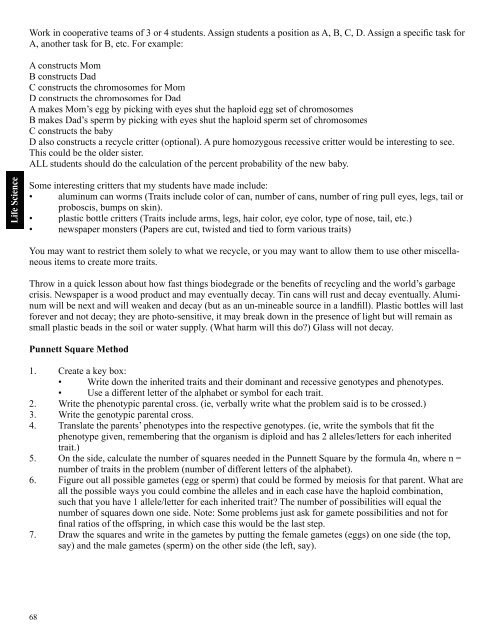ScienceMakers Toolkit Manual - The History Makers
ScienceMakers Toolkit Manual - The History Makers
ScienceMakers Toolkit Manual - The History Makers
Create successful ePaper yourself
Turn your PDF publications into a flip-book with our unique Google optimized e-Paper software.
Life Science<br />
Work in cooperative teams of 3 or 4 students. Assign students a position as A, B, C, D. Assign a specifi c task for<br />
A, another task for B, etc. For example:<br />
A constructs Mom<br />
B constructs Dad<br />
C constructs the chromosomes for Mom<br />
D constructs the chromosomes for Dad<br />
A makes Mom’s egg by picking with eyes shut the haploid egg set of chromosomes<br />
B makes Dad’s sperm by picking with eyes shut the haploid sperm set of chromosomes<br />
C constructs the baby<br />
D also constructs a recycle critter (optional). A pure homozygous recessive critter would be interesting to see.<br />
This could be the older sister.<br />
ALL students should do the calculation of the percent probability of the new baby.<br />
Some interesting critters that my students have made include:<br />
• aluminum can worms (Traits include color of can, number of cans, number of ring pull eyes, legs, tail or<br />
proboscis, bumps on skin).<br />
• plastic bottle critters (Traits include arms, legs, hair color, eye color, type of nose, tail, etc.)<br />
• newspaper monsters (Papers are cut, twisted and tied to form various traits)<br />
You may want to restrict them solely to what we recycle, or you may want to allow them to use other miscellaneous<br />
items to create more traits.<br />
Throw in a quick lesson about how fast things biodegrade or the benefi ts of recycling and the world’s garbage<br />
crisis. Newspaper is a wood product and may eventually decay. Tin cans will rust and decay eventually. Aluminum<br />
will be next and will weaken and decay (but as an un-mineable source in a landfi ll). Plastic bottles will last<br />
forever and not decay; they are photo-sensitive, it may break down in the presence of light but will remain as<br />
small plastic beads in the soil or water supply. (What harm will this do?) Glass will not decay.<br />
Punnett Square Method<br />
1. Create a key box:<br />
• Write down the inherited traits and their dominant and recessive genotypes and phenotypes.<br />
• Use a different letter of the alphabet or symbol for each trait.<br />
2. Write the phenotypic parental cross. (ie, verbally write what the problem said is to be crossed.)<br />
3. Write the genotypic parental cross.<br />
4. Translate the parents’ phenotypes into the respective genotypes. (ie, write the symbols that fi t the<br />
phenotype given, remembering that the organism is diploid and has 2 alleles/letters for each inherited<br />
trait.)<br />
5. On the side, calculate the number of squares needed in the Punnett Square by the formula 4n, where n =<br />
number of traits in the problem (number of different letters of the alphabet).<br />
6. Figure out all possible gametes (egg or sperm) that could be formed by meiosis for that parent. What are<br />
all the possible ways you could combine the alleles and in each case have the haploid combination,<br />
such that you have 1 allele/letter for each inherited trait? <strong>The</strong> number of possibilities will equal the<br />
number of squares down one side. Note: Some problems just ask for gamete possibilities and not for<br />
fi nal ratios of the offspring, in which case this would be the last step.<br />
7. Draw the squares and write in the gametes by putting the female gametes (eggs) on one side (the top,<br />
say) and the male gametes (sperm) on the other side (the left, say).<br />
68










